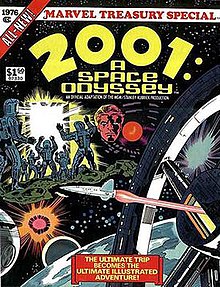

| 2001: A Space Odyssey | |
|---|---|

| |
| Publication information | |
| Publisher | Marvel Comics |
| Schedule | Monthly |
| Formats | Original material for the series has been published as a set of ongoing series and one-shot comics. |
| Genre | |
| Publication date | Treasury 1976 Series December 1976–September 1977 |
| Number of issues | Treasury 1 Series 10 |
| Creative team | |
| Writer(s) | Jack Kirby |
| Penciller(s) | Jack Kirby |
| Inker(s) | List
|
| Letterer(s) | List
|
| Colorist(s) | List
|
| Editor(s) | List
|
2001: A Space Odyssey is an oversized American comic book adaptation of the 1968 film of the same name as well as a ten-issue monthly series which expanded upon the concepts presented in the Stanley Kubrick film and the novelbyArthur C. Clarke. Jack Kirby wrote and pencilled both the adaptation and the series, which were published by Marvel Comics beginning in 1976. The adaptation was part of the agreement of Kirby's return to Marvel.
Marvel published the adaptation in its then-common treasury edition format featuring tabloid-sized pages of roughly twice the size of a standard American comic book.[1][2] The story is a close adaptation of the events of the film, but differs in the fact that Kirby incorporated additional dialog from two other sources: the novel[3] and a copy of an earlier draft script of the film that included the more colloquial-sounding version of HAL 9000, as originally voiced by actor Martin Balsam before he was replaced by Douglas Rain. In addition, the comic narrative captions describe the characters' thoughts and feelings, a significantly different approach from that taken by the film.
The treasury edition also contained a 10-page article entitled "2001: A Space Legacy" written by David Anthony Kraft.
Shortly after the publication of the treasury edition, Kirby continued to explore the concepts of 2001 in a monthly comic book series of the same name, the first issue of which was cover dated December 1976.[4] In this issue, Kirby followed the pattern established in the film. Once again the reader encounters a prehistoric man ("Beast-Killer") who gains new insight upon encountering a Monolith as did Moon-Watcher in the film. The scene then shifts, where a descendant of Beast-Killer is part of a space mission to explore yet another Monolith. When he finds it, this Monolith begins to transform the astronaut into a Star Child, called in the comic a "New Seed".[5]
Issues #1–6 of the series replay the same idea with different characters in different situations, both prehistoric and futuristic. In #7 (June 1977), the comic opens with the birth of a New Seed who then travels the galaxy witnessing the suffering that men cause each other. While the New Seed is unable or unwilling to prevent this devastation, he takes the essence of two doomed lovers and uses it to seed another planet with the potential for human life.[5]
In issue #8 (July 1977), Kirby introduces Mister Machine, who is later renamed Machine Man.[6] Mister Machine is an advanced robot designated X-51. All the other robots in the X series go on a rampage as they achieve sentience and are destroyed. X-51, supported by both the love of his creator Dr. Abel Stack and an encounter with a Monolith, transcends the malfunction that destroyed his siblings. After the death of Dr. Stack, X-51 takes the name Aaron Stack and begins to blend into humanity.[7] Issues #9 and 10, the final issues of the series, continue the story of X-51 as he flees destruction at the hands of the Army.[5]
Allusions are made to the series in the Agents of S.H.I.E.L.D. season 3 episode "4,722 Hours".[8]
Marvel published its adaptation of director Stanley Kubrick and writer Arthur C. Clarke's classic science fiction film 2001: A Space Odyssey as an oversize Marvel Treasury Special.
It is clear that Jack read Clarke's original novel, for in a couple of instances Kirby prefers the Clarke novel over the Kubrick film.
|
Arthur C. Clarke's Space Odyssey series
| |
|---|---|
| Short stories |
|
| Films |
|
| Novels |
|
| Non-fiction |
|
| Comics |
|
| Elements |
|
| Related |
|